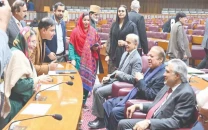Daughters of Al Huda
We are wrong to look for terrorist tracts in madrassas. The suicide bomber is not made through syllabi, but isolation.

Daughters of Al Huda
Sadaf Ahmad is an assistant professor at the Lahore University of Management Sciences (LUMS) in Lahore. Her book Transforming Faith: The story of Al Huda and Islamic Revivalism among Urban Pakistani Women (Syracuse University Press 2009) studies a women’s "dars" group called Al Huda. Al Huda ladies wear hijab and abaya and are found in the big cities. They are usually well-heeled, using the group-isolating dars activity to reinvent personal identity through 'discovery' of Islam. Al Huda was founded in 1994 by Farhat Hashmi and husband Idrees Zubair, both PhDs from Scotland’s famous centre of Islamic learning, the University of Glasgow. Farhat, from Sargodha, where her parents were both members of Islami Jamiat Tulaba, is steeped in the “dars” of the Jamaat-e-Islami and Maulana Maududi’s thought (p 40).
I may sound prejudiced, but the book is not. It is completely without bias and is thoroughly researched. The Farhat-Idrees duo succeeded beyond expectations as their following among the middle and upper middle-class women swelled. Among the half a dozen “dars” groups busy alienating women in Islamabad, Al Huda towered as the most powerful – “symbolised by a large three-storey house on Nazimuddin Road in Islamabad” — spreading to other big cities too (p 41). The objective was to give “authentic knowledge of Quran and Sunna”, cutting off the “cultural accretions” that Maududi – and now the Taliban – reject.
Al Huda ladies began to alarm with their rejection of society. Some orthodox Muslims began to ask questions. The book says: “Farhat Hashmi moved to Canada in 2005, and apparently there are a number of Muslims there who want her to leave” (p 196). The reason for the fear that some Canadian Muslims feel could be Al Huda’s rejection as ‘bidaa’ — of photography, all festivals, birthday celebrations, including the birthday of the Prophet (pbuh), and of the widespread practice of ‘chehlum’ after death (p 107). The book says: “Farhat Hashmi’s denouncement of various cultural practices and disapproval of westerners and Indians helps women redefine their own identity as Muslims” (p 146). The burden of men’s piety is on women who must not reveal themselves lest men be helplessly sexually aroused. And the husband cannot rape because he must not be refused “or the angels will curse her till morning” (p 170). The author found Al Huda graduates to be “very intolerant and judgmental toward people who were different from them” (p 193).
The Canadians are probably worried because Farhat thinks Osama bin Laden is an Islamic warrior. The author opines: “They react strongly to her statements, such as her claim that the 80,000 Pakistanis who died in the 2005 earthquake did so because they were involved in immoral activities and had left the path of Islam, and fear that her brand of extremist Islam will further marginalise their Muslim communities within the country” (p 196).
In December 2009, army officers and their children were massacred by terrorists while praying at the Parade Lane mosque in Rawalpindi. The ISI finally caught up with the man who had organised the attack – “a student of the International Islamic University”, whose father was a grade 19 officer in Islamabad with religious party connections, “while the mother held Quranic dars for women in Islamabad” (Herald, June 2010).
Published in The Express Tribune, August 22nd, 2010.













COMMENTS
Comments are moderated and generally will be posted if they are on-topic and not abusive.
For more information, please see our Comments FAQ